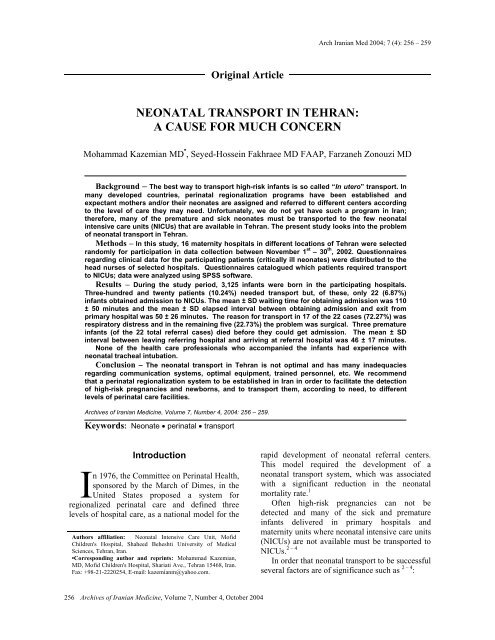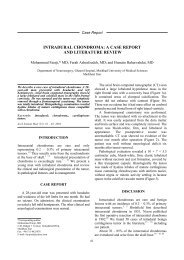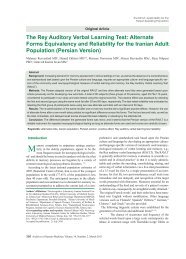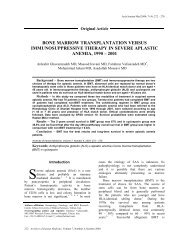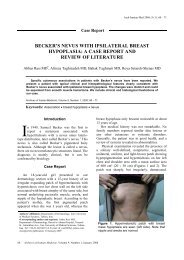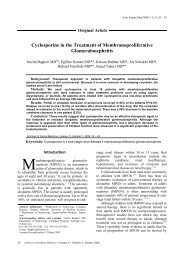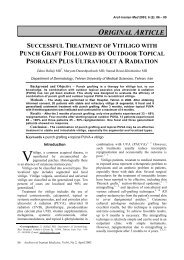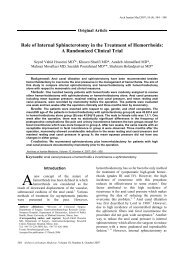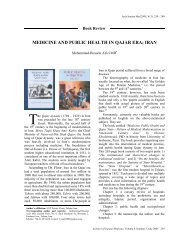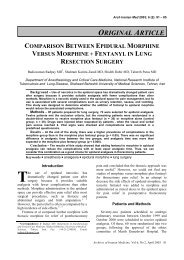NEONATAL TRANSPORT IN TEHRAN: A CAUSE FOR MUCH ...
NEONATAL TRANSPORT IN TEHRAN: A CAUSE FOR MUCH ...
NEONATAL TRANSPORT IN TEHRAN: A CAUSE FOR MUCH ...
Create successful ePaper yourself
Turn your PDF publications into a flip-book with our unique Google optimized e-Paper software.
Arch Iranian Med 2004; 7 (4): 256 – 259Original Article<strong>NEONATAL</strong> <strong>TRANSPORT</strong> <strong>IN</strong> <strong>TEHRAN</strong>:A <strong>CAUSE</strong> <strong>FOR</strong> <strong>MUCH</strong> CONCERNMohammad Kazemian MD • , Seyed-Hossein Fakhraee MD FAAP, Farzaneh Zonouzi MDBackground – The best way to transport high-risk infants is so called “In utero” transport. Inmany developed countries, perinatal regionalization programs have been established andexpectant mothers and/or their neonates are assigned and referred to different centers accordingto the level of care they may need. Unfortunately, we do not yet have such a program in Iran;therefore, many of the premature and sick neonates must be transported to the few neonatalintensive care units (NICUs) that are available in Tehran. The present study looks into the problemof neonatal transport in Tehran.Methods – In this study, 16 maternity hospitals in different locations of Tehran were selectedrandomly for participation in data collection between November 1 st – 30 th , 2002. Questionnairesregarding clinical data for the participating patients (critically ill neonates) were distributed to thehead nurses of selected hospitals. Questionnaires catalogued which patients required transportto NICUs; data were analyzed using SPSS software.Results – During the study period, 3,125 infants were born in the participating hospitals.Three-hundred and twenty patients (10.24%) needed transport but, of these, only 22 (6.87%)infants obtained admission to NICUs. The mean ± SD waiting time for obtaining admission was 110± 50 minutes and the mean ± SD elapsed interval between obtaining admission and exit fromprimary hospital was 50 ± 26 minutes. The reason for transport in 17 of the 22 cases (72.27%) wasrespiratory distress and in the remaining five (22.73%) the problem was surgical. Three prematureinfants (of the 22 total referral cases) died before they could get admission. The mean ± SDinterval between leaving referring hospital and arriving at referral hospital was 46 ± 17 minutes.None of the health care professionals who accompanied the infants had experience withneonatal tracheal intubation.Conclusion – The neonatal transport in Tehran is not optimal and has many inadequaciesregarding communication systems, optimal equipment, trained personnel, etc. We recommendthat a perinatal regionalization system to be established in Iran in order to facilitate the detectionof high-risk pregnancies and newborns, and to transport them, according to need, to differentlevels of perinatal care facilities.Archives of Iranian Medicine, Volume 7, Number 4, 2004: 256 – 259.Keywords: Neonate • perinatal • transportIntroductionIn 1976, the Committee on Perinatal Health,sponsored by the March of Dimes, in theUnited States proposed a system forregionalized perinatal care and defined threelevels of hospital care, as a national model for theAuthors affiliation: Neonatal Intensive Care Unit, MofidChildren's Hospital, Shaheed Beheshti University of MedicalSciences, Tehran, Iran.•Corresponding author and reprints: Mohammad Kazemian,MD, Mofid Children's Hospital, Shariati Ave., Tehran 15468, Iran.Fax: +98-21-2220254, E-mail: kazemianm@yahoo.com.rapid development of neonatal referral centers.This model required the development of aneonatal transport system, which was associatedwith a significant reduction in the neonatalmortality rate. 1Often high-risk pregnancies can not bedetected and many of the sick and prematureinfants delivered in primary hospitals andmaternity units where neonatal intensive care units(NICUs) are not available must be transported toNICUs. 2 – 4In order that neonatal transport to be successfulseveral factors are of significance such as 2 – 4 :256Archives of Iranian Medicine, Volume 7, Number 4, October 2004
M. Kazemian, S. H. Fakhraee, F. Zonouzi• well-functioning equipment (e.g. transportincubator, ventilator...);• trained personnel skilled in neonatalresuscitation and stabilization;• well-functioning and well-equipped vehicles;• good roads and highways; and• good communication between primary andreferral hospital.In Tehran there are few NICUs where thetrained personnel and necessary equipment areavailable for the care of high-risk neonates.Because of shortage of these facilities, many ofthe sick neonates who need to be transported cannot obtain admission. Even when they can obtainadmission, their transport is delayed and veryinefficient due to lack of good communication,transport vehicle, and trained personnel, etc. Inthis study, we attempt to clarify some of theinadequacies in regard to neonatal transport inTehran and to give some suggestions topolicymakers in order to improve neonataltransport and reduce neonatal morbidity andmortality.Patients and MethodsIn this study, 16 maternity hospitals withoutNICU facilities in different geographical locationsof Tehran were selected randomly forparticipation during the month of November 2002.All infants born at these hospitals during thatperiod who were candidates for transport toNICUs according to the universal standards wereincluded in this study. 6 By reviewing severaltransport protocols we prepared a questionnaireand distributed it to the head nurses of theneonatal units of the participating hospitals. Thepediatricians of these hospitals determined theeligibility of the neonates for transport accordingto the above-mentioned criteria.All of the information regarding the transportof these babies were extracted from thequestionnaires and analyzed using SPSS software.ResultsIn the participating hospitals, 3,125 infantswere born during the study period. Of these, 320(10.24%) needed admission to a special care unitdue to complications such as respiratory distressand surgical problems. Of the 320 patients whorequired transport and admission, only 22 infants(6.87%) from 13 centers were able to obtainadmission.Fifteen (68.18%) of the infants who receivedtransport were premature while seven (31.82%)were born full-term. The mean ± SD age of theinfants at the time of request for transport was 3.8± 3.07 hours and the mean ± SD birth weight was1.92 ± 0.28 kg. The reason for transport in 17cases (77.27%) was respiratory distress and in fiveothers (22.73%) transport was desired for surgicalproblems. Three of the fifteen premature infants(13.63% of all the infants requiring transport) diedbefore they could obtain admission.The mean ± SD waiting time for admissionwas 110 ± 50 min and the mean ± SD elapsedinterval between receiving confirmation ofadmission acceptance, and exiting the primaryhospital was 50 ± 26 min. The mean ± SD intervalbetween leaving the referring hospital and arrivingat referral hospital was 46 ± 17 min. In 16 cases(84.21%) the father accompanied the infant, whilein 3 cases (15.79%) another relative accompaniedthe infant. Health care professionals also oftenaccompanied the patient; in 15 cases (78.9%) anurse and in 4 cases (21.1%) interns accompaniedthe patient.Out of these 19 health care personnel whoaccompanied the patients, only 8 (42.1%) hadparticipated in neonatal resuscitation workshops.None of the transported infants was intubated butall of them had intravenous lines.In 11 cases (57.9%) the transport vehicle was ahospital ambulance while in rest of the cases, itwas a private ambulance. None of the ambulanceshad optimal equipment such as proper-sized bagand mask, transport incubators, monitors,equipment for temperature regulation, or transportventilators. In seven cases, (36.84%) a transportincubator was used and in 12 cases (63.16%)blankets were used to warm the baby duringtransport. Cardiopulmonary resuscitation (CPR)was performed on one premature infant duringtransport. It was unsuccessful and the patient diedbefore reaching the referral hospital. Three otherpremature infants had mechanical ventilationintermittently with bag and mask during transportbut none was intubated. None of the health careprofessionals who accompanied the babies hadexperience with neonatal tracheal intubation.DiscussionIn most developed countries, critically illArchives of Iranian Medicine, Volume 7, Number 4, October 2004 257
Neonatal transport in Tehranneonates are often born in specialized centerseither because the referral center routinely deliverscare to at-risk perinatal populations, or due toprenatal detection of a problem. These babies arecalled "inborn." A large number of outbornneonates, however, require emergent transfer to atertiary care center, often due to medical, surgical,2, 3, 4or rapidly emerging postpartum problems.Since the outcome of an outborn neonate withmajor medical or surgical problems remains worsethan an inborn infant, primary emphasis shouldalways remain on prenatal diagnosis andsubsequent maternal transfer whenever possible.Despite advanced training and technology,mothers usually make the best transport incubators2, 3, 4(i.e.: in utero transport).In 1976, the Committee on Perinatal Health,sponsored by the March of Dimes, of the UnitedStates proposed a system for regionalizedperinatal care and defined three levels of hospitalcare, as a national model for the rapiddevelopment of neonatal referral centers. Thismodel required the development of a neonataltransport system, which was associated with asignificant reduction in the neonatal mortalityrate. 1 According to the regionalization programswhich were established during the early 1970s inmost of Europe and North America, three levels ofperinatal and neonatal care are defined andexpectant mothers are assigned to these levelsearly in pregnancy according to their needs. 2 – 4Despite the fact that intrauterine transport isthe best mode of transporting premature and highriskfetuses to specialized centers, this procedureis still not practiced in Tehran. The reasons for notpracticing this method in Tehran are several,including:• many obstetricians invest a majority of theirtime working in private hospitals. Comparedto public hospitals, private hospitals lack manyof the necessary hospitals for care of high-riskneonates. Those high-risk neonates born inprivate facilities must be transferred to publichospitals to receive the required care;• lack of a regionalization program for perinataland neonatal care;• inadequate number of specialized centers forcare of high-risk deliveries (care of mother andneonate);• lack of adequate communication betweenprimary and referral hospitals;• the few available NICU facilities are located inpediatric hospitals, which are far away frommaternity units;• lack of good transport resources; and• lack of a centralized transport unit to arrangetransports to specialized centers.According to the present study, less than 7% ofthe high-risk neonates delivered in Tehran couldget admission to specialized care centers. Theoutcome of more than 90% of these deliveries isnot known by us and is a subject for anotherstudy. The present study shows that the referringhospitals spend a considerable amount of time toget admission from the referral hospitals. Thislapsed time sometimes causes significantmorbidity and mortality in the sick newborns. Oneof the most important factors in this delay is thelack of a centralized transport unit in Tehran forarranging all neonatal transports.To achieve safe and rapid transport, thereshould be a centralized unit in each region thatreceives all requests for the transport of sickinfants and arranges their transport to differentreferral hospitals in the region according to theirneeds and levels of required care. 1 Unfortunately,there is currently not such a center in Tehran andthe referring hospitals and families have to checkmany hospitals hoping that they may be able tofind a place to which they can transport their sickinfant. Unfortunately, families and staff spend avaluable amount of time in this process and thistime is very critical and important in neonatalcare.Another important problem in neonataltransport in Tehran is the lack of adequatecommunication between referring and admittingphysicians. The information given to the referralhospitals is, in most cases, insufficient and givenby a nurse or paramedical personnel rather than aphysician. One of the main factors in successfultransport is the stabilization of the neonate beforetransport . 2 – 7 This is not often practiced in Tehranand sick infants are transported before they arestabilized. This is one of the main factors thatincreases the morbidity and mortality of theseinfants.Equipment such as transport incubators,monitors, and tools for mechanical ventilation areinadequate and malfunction in many cases duringtransport. Even when equipment are available, thetransport team often can not use them effectivelydue to lack of training.In summary, the present study shows that all258Archives of Iranian Medicine, Volume 7, Number 4, October 2004
M. Kazemian, S. H. Fakhraee, F. Zonouziaspects of neonatal transport includingcommunication, skills and knowledge of healthcare professionals, facilities, and equipment arevery inadequate and inefficient in Tehran.Considerations for policymakersWe suggest that a perinatal regionalizationprogram, as exists in many developed countries,be established as soon as possible in Iran in orderto decrease maternal-neonatal morbidity andmortality. For the time being, we recommend thefollowings:• Establishment of a centralized transport unit ineach medical university which will receive allrequests for transport from its surroundingterritory and will arrange for transport.• A good communication system betweenreferring and referral hospitals through thetransport unit.• Delivery of the required information to thereferral hospital by the referring physician.• Training of all health care professionalsresponsible for the care of neonates in neonatalstabilization and resuscitation.• Availability of well-functioning equipment forthe resuscitation and transport of the criticallyill infants.References1 Ohning BL, Driggers KP. Transport of the critically illnewborn. eMedicine, May 23, 2001. Available from:URL: http://www.eMedicine.com.2 Bose CL, Neonatal transport. In: Avery GB, FletcherMA, MacDonald MG, eds. Neonatology:Pathophysiology and Management of the Newborn. 5thed. Philadelphia: Lippincott, Williams and Wilkins; 1999:35 – 47.3 Fanaroff AA, Martin RJ. Neonatal-Perinatal Medicine:Diseases of the Fetus and Infant. 7th ed. St. Louis:Mosby; 2002: 31 – 32.4 Cloherty JP, Stark AR, Ann R. Manual of Neonatal Care.4th ed. Philadelphia: Lippincott-Raven; 2004: 151 – 157.5 Klaus MH, Fanaroff AA. Care of the High-Risk Neonate.5th ed. Philadelphia: WB Saunders; 2001: 93 – 94.6 American Academy of Pediatrics and American Collegeof Obstetrics and Gynecologists. Interhospital care of theperinatal patient. In: American Academy of Pediatrics,American College of Obstetricians and Gynecologists,eds. Guidelines for Perinatal Care. 5th ed. Elk GroveVillage, IL: American Academy of Pediatrics;Washington, DC: American College of Obstetricians andGynecologists; 2002: 57 – 71.7 MacCloskey K, Hackel A, Notterman D. Guidelines forair and ground transport. AAP; 1993: 146.Archives of Iranian Medicine, Volume 7, Number 4, October 2004 259


